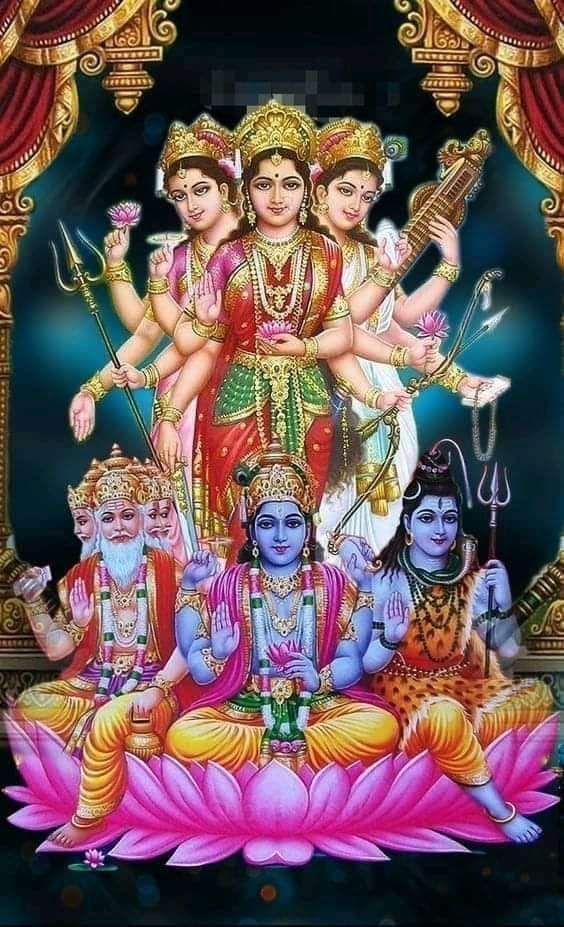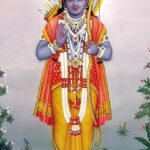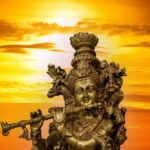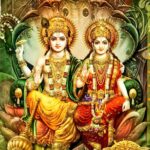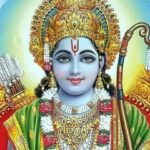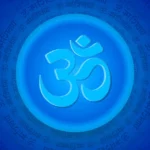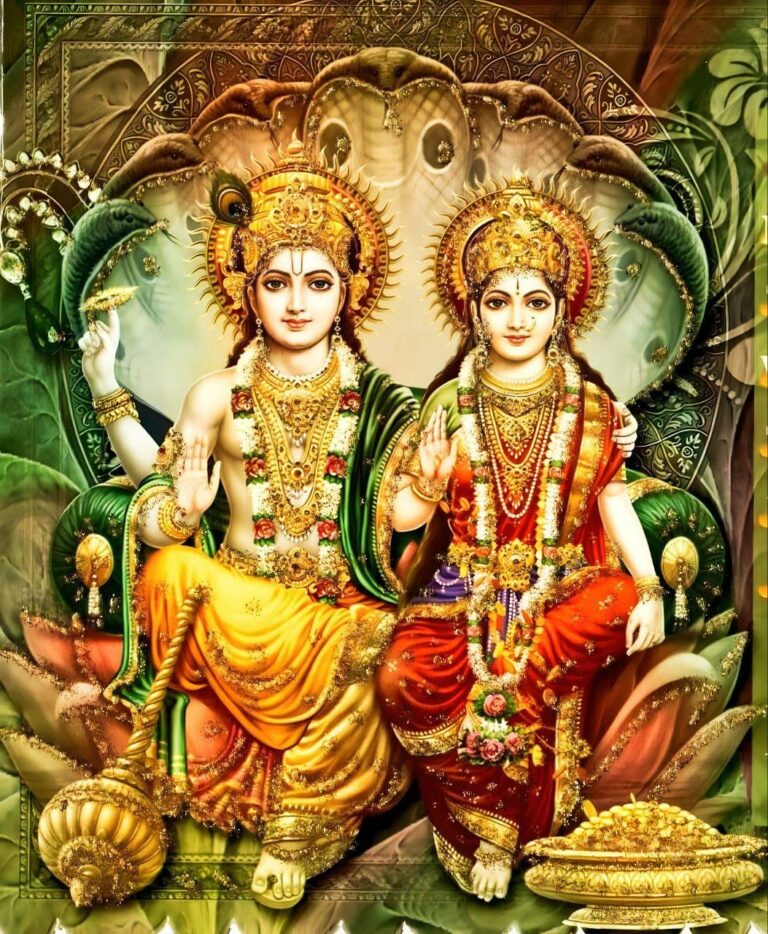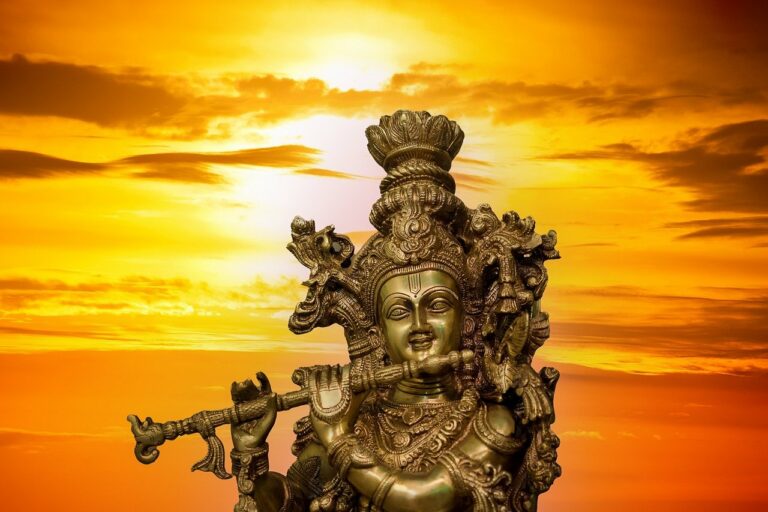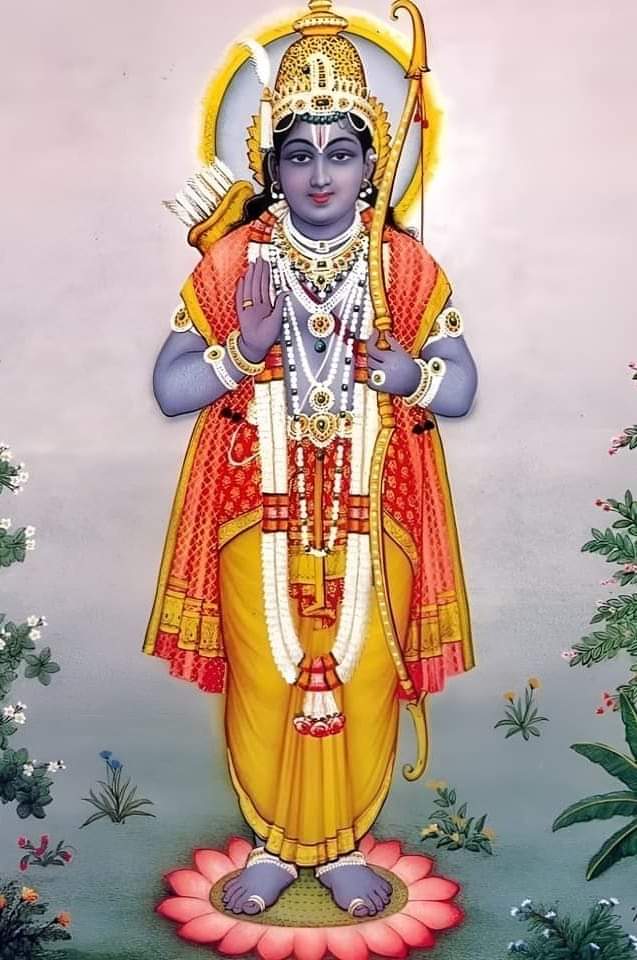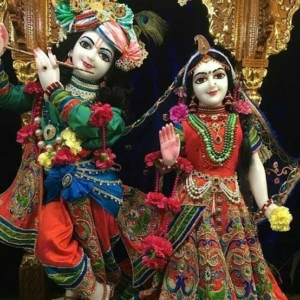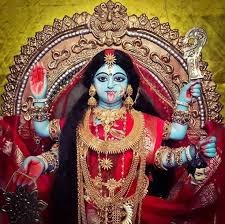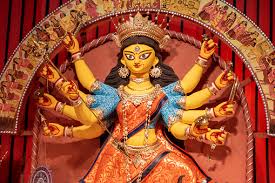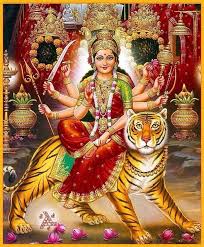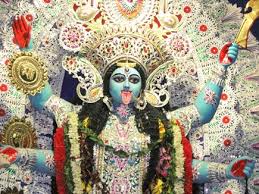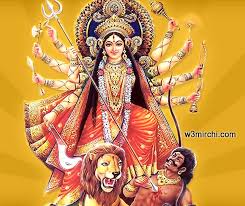।
हिंदू महाकाव्य के अनुसार, मां वैष्णो देवी ने भारत के दक्षिण में रत्नाकर सागर के घर जन्म लिया। उनके लौकिक माता-पिता लंबे समय तक निःसंतान थे।
दैवी बालिका के जन्म से एक रात पहले, रत्नाकर ने वचन लिया कि बालिका जो भी चाहे, वे उसकी इच्छा के रास्ते में कभी नहीं आएंगे। मां वैष्णो देवी को बचपन में त्रिकुटा नाम से बुलाया जाता था। बाद में भगवान विष्णु के वंश से जन्म लेने के कारण वे वैष्णवी कहलाईं।
जब त्रिकुटा ९ साल की थीं, तब उन्होंने अपने पिता से समुद्र के किनारे पर तपस्या करने की अनुमति चाही। त्रिकुटा ने राम के रूप में भगवान विष्णु से प्रार्थना की। सीता की खोज करते समय श्री राम अपनी सेना के साथ समुद्र के किनारे पहुंचे। उनकी दृष्टि गहरे ध्यान में लीन इस दिव्य बालिका पर पड़ी।
त्रिकुटा ने श्री राम से कहा कि उसने उन्हें अपने पति के रूप में स्वीकार किया है। श्री राम ने उसे बताया कि उन्होंने इस अवतार में केवल सीता के प्रति निष्ठावान रहने का वचन लिया है। लेकिन भगवान ने उसे आश्वासन दिया कि कलियुग में वे कल्कि के रूप में प्रकट होंगे और उससे विवाह करेंगे।
इस बीच, श्री राम ने त्रिकुटा से उत्तर भारत में स्थित माणिक पहाड़ियों की त्रिकुटा श्रृंखला में अवस्थित गुफ़ा में ध्यान में लीन रहने के लिए कहा। रावण के विरुद्ध श्री राम की विजय के लिए मां ने ‘नवरात्र’ मनाने का निर्णय लिया।
इसलिए उक्त संदर्भ में लोग, नवरात्र के ९ दिनों की अवधि में रामायण का पाठ करते हैं। श्री राम ने वचन दिया था कि समस्त संसार द्वारा मां वैष्णो देवी की स्तुति गाई जाएगी। त्रिकुटा, वैष्णो देवी के रूप में प्रसिद्ध होंगी और सदा के लिए अमर हो जाएंगी।
समय के साथ-साथ, देवी मां के बारे में कई कहानियां उभरीं। ऐसी ही एक कहानी है श्रीधर की- श्रीधर मां वैष्णो देवी का प्रबल भक्त थे। वे वर्तमान कटरा कस्बे से २ कि॰मी॰ की दूरी पर स्थित हंसली गांव में रहता थे। एक बार मां ने एक मोहक युवा लड़की के रूप में उनको दर्शन दिए।
युवा लड़की ने विनम्र पंडित से ‘भंडारा’ (भिक्षुकों और भक्तों के लिए एक प्रीतिभोज) आयोजित करने के लिए कहा। पंडित गांव और निकटस्थ जगहों से लोगों को आमंत्रित करने के लिए चल पड़े। उन्होंने एक स्वार्थी राक्षस ‘भैरव नाथ’ को भी आमंत्रित किया। भैरव नाथ ने श्रीधर से पूछा कि वे कैसे अपेक्षाओं को पूरा करने की योजना बना रहे हैं।
उसने श्रीधर को विफलता की स्थिति में बुरे परिणामों का स्मरण कराया। चूंकि पंडित जी चिंता में डूब गए, दिव्य बालिका प्रकट हुईं और कहा कि वे निराश ना हों, सब व्यवस्था हो चुकी है। उन्होंने कहा कि ३६० से अधिक श्रद्धालुओं को छोटी-सी कुटिया में बिठा सकते हो। उनके कहे अनुसार ही भंडारा में अतिरिक्त भोजन और बैठने की व्यवस्था के साथ निर्विघ्न आयोजन संपन्न हुआ।
भैरव नाथ ने स्वीकार किया कि बालिका में अलौकिक शक्तियां थीं और आगे और परीक्षा लेने का निर्णय लिया। उसने त्रिकुटा पहाड़ियों तक उस दिव्य बालिका का पीछा किया। ९ महीनों तक भैरव नाथ उस रहस्यमय बालिका को ढूँढ़ता रहा, जिसे वह देवी मां का अवतार मानता था।
भैरव से दूर भागते हुए देवी ने पृथ्वी पर एक बाण चलाया, जिससे पानी फूट कर बाहर निकला। यही नदी बाणगंगा के रूप में जानी जाती है। ऐसी मान्यता है कि बाणगंगा (बाण: तीर) में स्नान करने पर, देवी माता पर विश्वास करने वालों के सभी पाप धुल जाते हैं।
नदी के किनारे, जिसे चरण पादुका कहा जाता है, देवी मां के पैरों के निशान हैं, जो आज तक उसी तरह विद्यमान हैं। इसके बाद वैष्णो देवी ने अर्द्धकुवारी के पास गर्भ जून में शरण ली, जहां वे ९ महीनों तक ध्यान-मग्न रहीं और आध्यात्मिक ज्ञान और शक्तियां प्राप्त कीं। भैरव द्वारा उन्हें ढूंढ़ लेने पर उनकी साधना भंग हुई।
जब भैरव ने उन्हें मारने की कोशिश की, तो विवश होकर वैष्णो देवी ने महा काली का रूप लिया। दरबार में पवित्र गुफ़ा के द्वार पर देवी मां प्रकट हुईं। देवी ने ऐसी शक्ति के साथ भैरव का सिर धड़ से अलग किया कि उसकी खोपड़ी पवित्र गुफ़ा से २.५ कि॰मी॰ की दूरी पर भैरव घाटी नामक स्थान पर जा गिरी।
भैरव ने मरते समय क्षमा याचना की।
देवी जानती थीं कि उन पर हमला करने के पीछे भैरव की प्रमुख मंशा मोक्ष प्राप्त करने की थी। उन्होंने न केवल भैरव को पुनर्जन्म के चक्र से मुक्ति प्रदान की, बल्कि उसे वरदान भी दिया कि भक्त द्वारा यह सुनिश्चित करने के लिए कि तीर्थ-यात्रा संपन्न हो चुकी है, यह आवश्यक होगा कि वह देवी मां के दर्शन के बाद, पवित्र गुफ़ा के पास भैरव नाथ के मंदिर के भी दर्शन करें.इस बीच वैष्णो देवी ने तीन पिंड (सिर) सहित एक चट्टान का आकार ग्रहण किया और सदा के लिए ध्यानमग्न हो गईं।
इस बीच पंडित श्रीधर अधीर हो गए। वे त्रिकुटा पर्वत की ओर उसी रास्ते आगे बढ़े, जो उन्होंने सपने में देखा था। अंततः वे गुफ़ा के द्वार पर पहुंचे। उन्होंने कई विधियों से ‘पिंडों’ की पूजा को अपनी दिनचर्या बना ली।
देवी उनकी पूजा से प्रसन्न हुईं। वे उनके सामने प्रकट हुईं और उन्हें आशीर्वाद दिया। तब से, श्रीधर और उनके वंशज देवी मां वैष्णो देवी की पूजा करते आ रहे हैं।
।। माता वैष्णो देवी की जय ।।
, Hail Mother Vaishnavi.
According to Hindu epic, Maa Vaishno Devi took birth in the house of Ratnakar Sagar in the south of India. His earthly parents were childless for a long time.
The night before the birth of the divine child, Ratnakar took a vow that whatever the child desired, he would never come in the way of her wish. Mother Vaishno Devi was called by the name Trikuta in her childhood. Later she came to be known as Vaishnavi because of being born from the lineage of Lord Vishnu.
When Trikuta was 9 years old, he asked his father for permission to do penance on the seashore. Trikuta prayed to Lord Vishnu in the form of Rama. While searching for Sita, Shri Ram reached the sea shore with his army. His eyes fell on this divine girl engrossed in deep meditation.
Trikuta told Sri Rama that she had accepted him as her husband. Sri Rama told him that he had taken a vow to be loyal only to Sita in this incarnation. But the Lord assured her that in Kaliyuga he would appear as Kalki and marry her.
Meanwhile, Sri Rama asked Trikuta to meditate in a cave located in the Trikuta range of Manik hills in northern India. Mother decided to celebrate ‘Navratri’ for the victory of Shri Ram against Ravana.
Hence in the above context people recite Ramayana during the period of 9 days of Navratras. Shri Ram had promised that the praise of Maa Vaishno Devi would be sung by the whole world. Trikuta will be famous as Vaishno Devi and will be immortal forever.
Over time, several stories about the Mother Goddess emerged. One such story is of Sridhar – Sridhar was an ardent devotee of Maa Vaishno Devi. He lived in Hansali village, 2 km from the present Katra town. Once the mother appeared to him in the form of a charming young girl.
The young girl asked the humble pundit to organize a ‘bhandara’ (a feast for mendicants and devotees). The pundits set out to invite people from the village and nearby places. He also invited a selfish demon ‘Bhairav Nath’. Bhairav Nath asks Sridhar how he plans to fulfill the expectations.
He reminded Sridhar of the dire consequences in case of failure. As Pandit ji was immersed in worry, the divine girl appeared and told him not to be disheartened, everything has been arranged. He said that more than 360 devotees can be accommodated in a small cottage. The event went off smoothly with extra food and seating arrangements at Bhandara as per his instructions.
Bhairav Nath accepted that the girl had supernatural powers and decided to conduct further tests. He followed the divine girl till the Trikuta hills. For 9 months, Bhairav Nath kept searching for the mysterious girl who he believed to be an incarnation of Mother Goddess.
Running away from Bhairav, the goddess shot an arrow at the earth, causing water to burst forth. This river is known as Banganga. It is believed that by taking a bath in Banganga (Baan: Arrow), all the sins of those who believe in Mother Goddess are washed away.
On the banks of the river, called Charan Paduka, are the footprints of the Mother Goddess, which are still present today. Vaishno Devi then took refuge in Garbh Joon near Ardhakuvari, where she meditated for 9 months and gained spiritual knowledge and powers. His meditation was interrupted when Bhairav found him.
When Bhairav tried to kill her, Vaishno Devi was forced to take the form of Maha Kali. The Mother Goddess appeared at the door of the holy cave in the court. The Goddess beheaded Bhairav with such force that his skull fell at a place called Bhairav Ghati, 2.5 km from the holy cave.
Bhairav apologized while dying.
Devi knew that Bhairav’s main motive behind attacking her was to attain salvation. He not only freed Bhairava from the cycle of rebirth, but also gave him a boon that it would be necessary for the devotee to visit the holy cave, after having darshan of the Mother Goddess, to ensure that the pilgrimage was complete. Also visit the temple of Bhairav Nath nearby. Meanwhile Vaishno Devi assumed the shape of a rock with three pindas (heads) and became eternally meditative.
Meanwhile Pandit Sridhar became impatient. He proceeded towards Trikuta mountain on the same path which he had seen in his dream. At last they reached the entrance of the cave. He made the worship of ‘Pindas’ his routine in many ways.
The goddess was pleased with his worship. She appeared before him and blessed him. Since then, Shridhar and his descendants have been worshiping Goddess Maa Vaishno Devi.
, Hail Mother Vaishno Devi.

